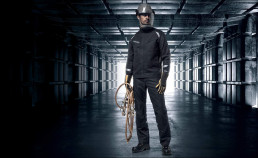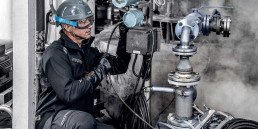Electricity keeps our world running. We depend on it from the second we wake up: for our alarm clock, the light, the coffee machine, our electric toothbrush and our car – the list goes on. Because even products that aren’t powered by electricity need it for their production and packaging. But electricity is as dangerous for humans as it is indispensable. Working on high-voltage power lines can result in fatalities if sufficient protection is not used. We tell you the types of PPE that are best for protecting yourself during live working and which items of uvex protective clothing can even withstand short circuit electric arcs.
What are short circuit electric arcs?
An arc is an electrical breakdown of a gas that produces a prolonged electrical discharge. If the arc is triggered by an operational malfunction or human error, it is called a short circuit electric arc. These can occur in working environments containing electrical installations. Although short circuit electric arcs are rare, the risk of one should never be ruled out or underestimated. Short circuit electric arcs are caused by short circuits or incorrectly disconnected live parts. This electrical discharge represents an extreme or even life-threatening hazard.
Hazards caused by short circuit electric arcs:
- High thermal energy
- Poisonous gases and particles
- High-impact pressure wave (arc blast)
- Optical radiation
- High acoustic stress due to the arc blast
- High risk of burns
Due to the lethal nature of this hazard, category 3 personal protective equipment (PPE) is required to ensure adequate protection against short circuit electric arcs.
Electrical insulating gloves – DIN EN 60903
During live working, your hands are in direct contact with high-voltage power lines and live cables. You should therefore adequately protect your hands against electrical and thermal hazards.
Use electrical insulating gloves that comply with DIN EN 60903 – the standard for live working. DIN EN 60903-compliant safety gloves are category iii PPE. The insulation protection class of the insulating personal protective equipment (PPE) is determined according to the nominal voltage of the installation, with both the maximum permissible nominal AC voltage (AC) and the nominal DC voltage (DC) being calculated.
| Insulation protection class | Max. permissible nominal AC voltage (AC) | Max. permissible nominal direct voltage (DC) |
| 00 | 500 volts | 750 volts |
| 0 | 1,000 volts | 1,500 volts |
| 1 | 7,500 volts | 11,250 volts |
| 2 | 17,000 volts | 25,500 volts |
| 3 | 26,500 volts | 39,750 volts |
| 4 | 36,000 volts | 54,000 volts |
The standard also tests whether the safety gloves are resistant to acid (A), oil (H), ozone (Z) and extremely low temperatures (C). After contact with A, H or Z, the gloves should be disposed of.
The electrical and physical properties of electrical insulating gloves are tested both according to the European (EN) standard and to the international standard (IEC). Unlike the European standard, the international standard also requires a routine dielectric test for insulation protection classes 0 and 00.

Testing short circuit electric arc gloves
The standard EN 61482-1-2 is used as a basis for testing gloves for protection against short circuit electric arcs in the absence of a European glove standard for such protection. In the so-called box test according to EN 61482-1-2, heat transmission on the back of the safety gloves is measured. The Stoll curve is used to determine whether the short circuit electric arc gloves prevent second-degree burns. The test also checks that the inner material of the safety gloves has not melted and that there are no holes larger than 5 mm in diameter. The burning time must not exceed 5 seconds. This European standard is mainly designed for low-voltage applications.
Another test method is the US standard ASTM F2675 – Standard Test Method for Determining Arc Ratings of Hand Protective Products Developed and Used for Electrical Arc Flash Protection. This test method determines the ability of a safety glove material to protect against short circuit electric arcs. The measured value is used to classify the glove in hazard risk categories HRC1 to HRC4. However, this is not a recognised procedure in Germany. This US standard is mainly intended for use with medium- and high-voltage applications.

uvex offers two models of gloves for live working: uvex power protect V1000 and uvex arc protect g1. Both were designed for use by breakdown services, fire brigades and electricians. uvex power protect V1000 was developed for live working up to 1,000 volts and therefore primarily offers protection against electric shocks, making these electrical insulating gloves ideal for battery production in the automotive industry and for use in the e-mobility sector.
In contrast, uvex arc protect g1 offers special protection against the thermal risks of a short circuit electric arc and is therefore ideal for live working. For this reason, the short circuit electric arc gloves are mainly used in plant construction, e.g. for the assembly of switch boxes.
Working on electrical installations – category 3 PPE
During live working, which always carries a risk of short circuit electric arcs, not only must the hands be adequately protected, the rest of the body should also be protected against thermal and electrical hazards. uvex has developed two collections that offer such protection: uvex suXXeed multifunction and uvex suXXeed arc. Both product groups offer sufficient protection against short circuit electric arcs during high-voltage work. uvex protective clothing with thermal insulation is used in many sectors, including in plant construction, the automotive, chemical and energy industries, and by electricians.

Most people only think of a helmet as providing protection against falling objects. However, you should also protect your head during live working – an electrical insulating helmet will prevent a dangerous electric current from passing through your head. The uvex pheos E-WR is completely metal-free and offers protection up to 1,000 volts. A visor and earmuffs can also be attached to the safety helmet. The eyes may be permanently damaged by short circuit electric arcs. Use the Class 1 visor for protection from electrical arcs to protect your eyes and face from Class 1 short circuit electric arcs.

You should also pay close attention to materials and quality when choosing your work shoes. At present, there are no standard requirements for protecting the feet against short circuit electric arcs. Although the risk of thermal damage to the feet is very low, we nevertheless recommend safety shoes with a leather upper. You should also make sure that your footwear is closed and not damaged, especially in the area of the toe cap.
But you should also not lose sight of the goal of electrical insulation during live working. You can only come closer to achieving this goal with insulating polymer boots, overshoes or rubber mats.
Do you carry out live work? We’d love to hear about your experiences of high-voltage work and how you protect yourself from the dangers of short circuit electric arcs. Perhaps we’ve been able to introduce you to one or two PPE products that you weren’t aware of before. We’d be happy to provide you with more detailed information on our protective clothing for live working. Get in touch!
Great Post!! i have read your blog, its very informative. I am so impressed to read this blog. thanks for sharing.